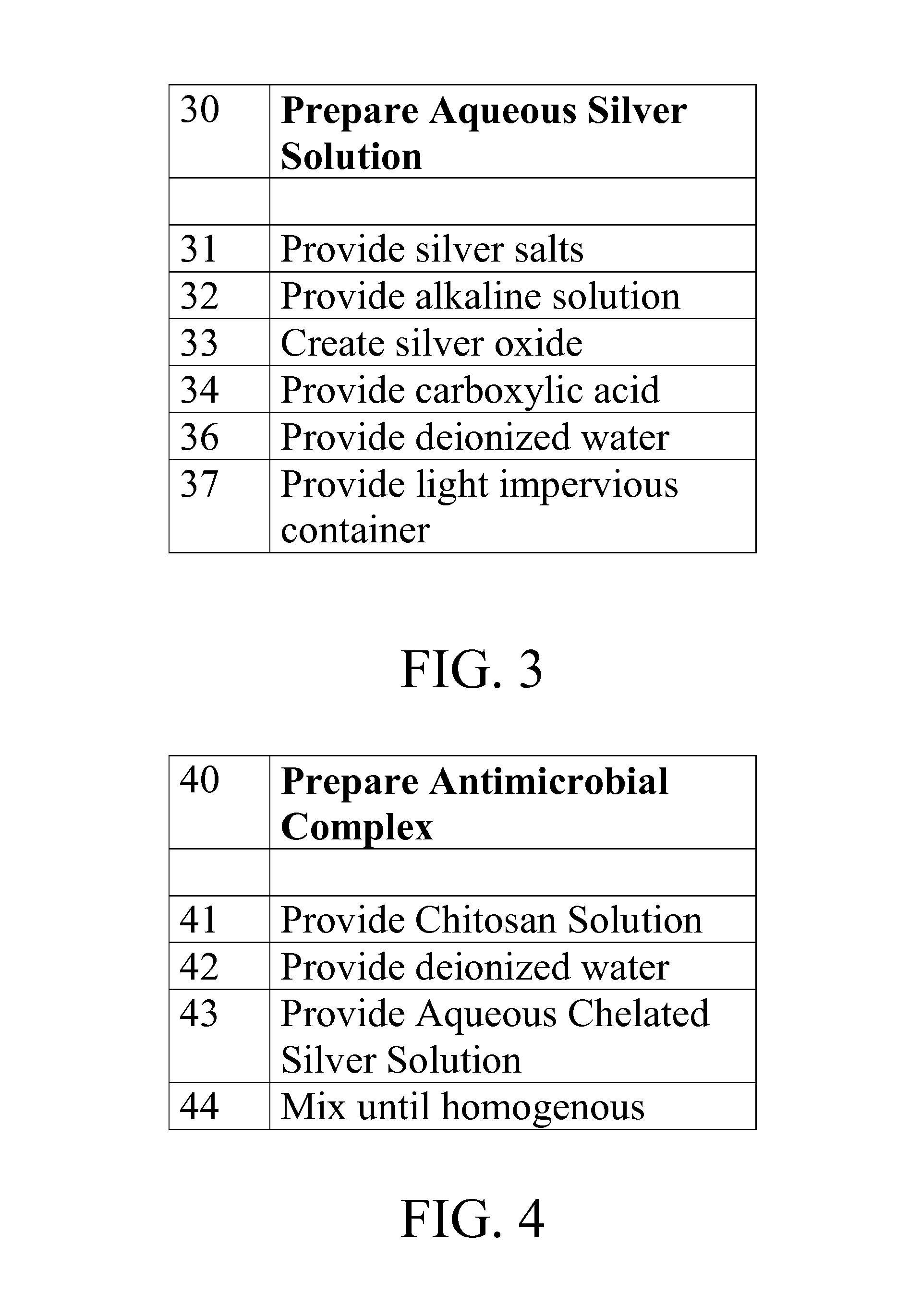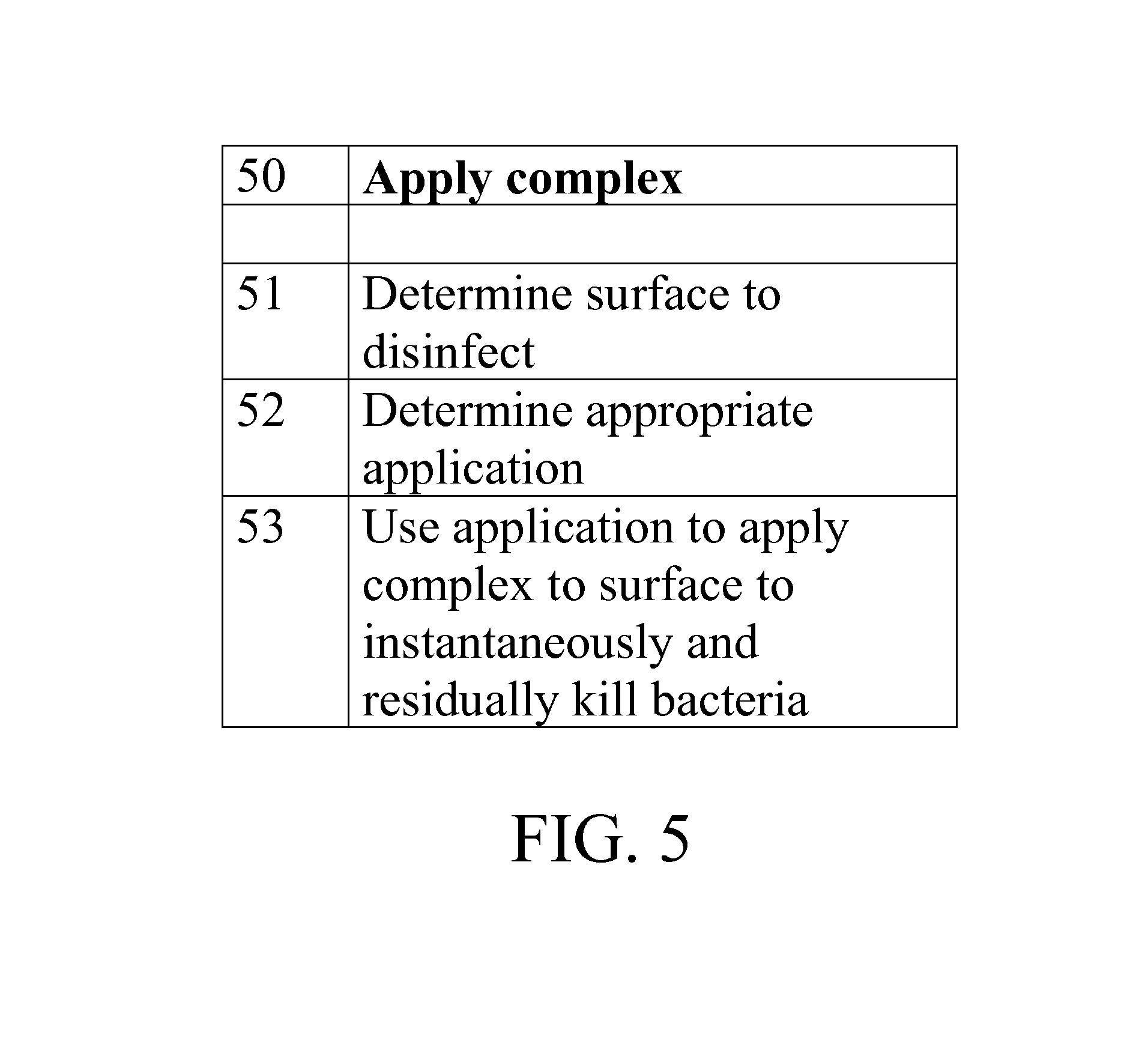Antimicrobial solution and methods of making and using the same
a technology of antimicrobial solution and topical solution, which is applied in the field of antimicrobial topical solution, can solve the problems of killing bacteria, and achieve the effects of convenient bonding to the skin of users, stable and portable, and high residual effectiveness
- Summary
- Abstract
- Description
- Claims
- Application Information
AI Technical Summary
Benefits of technology
Problems solved by technology
Method used
Image
Examples
example 1
[0046]A 500 ml amount of 100 ppm hand sanitizer was prepared in the following manner:
[0047]Solution A
[0048]0.265 gms. Citric Acid and add to
[0049]299.735 gms. Distilled Water
[0050]Mix 5-10 minutes
[0051]Slurry 1
[0052]0.11 gms. Silver Oxide and add to
[0053]99.89 gms. Distilled Water
[0054]Disperse 5-10 minutes
[0055]Take prepared Solution A and place under moderate agitation for the stipulated time. Slowly add the previously dispersed silver oxide in water Slurry 1 and mix at high speed for 30-45 minutes. The resulting silver chelate will be colorless and odorless. Remove from agitation, filter through a qualitative analysis filter paper, such as VWR 20 415, and set aside in a light impervious container. The silver is now ready to be used as a hand sanitizer. Take 30 mls of the 2% chitosan solution and to it add 70 mls distilled water. Mix for 1 minute and then add to the 400 mls of prepared chelated silver. Mix all for 3 minutes before use. The solution may be made to foam by the addit...
example 2
[0056]The product may be utilized as the solution to impregnate both non woven and natural fiber wipes.
[0057]A 500 ppm sanitizer solution was prepared in the following manner:
[0058]Solution A
[0059]0.685 gms. Citric Acid and add to
[0060]299.315 gms. Distilled Water
[0061]Mix 5-10 minutes
[0062]Slurry 1
[0063]0.275 gms. Silver Oxide and add to
[0064]99.725 gms. Distilled Water
[0065]Disperse 5-10 minutes
[0066]Take 15 ml of 2% chitosan solution and add to 85 mls distilled water and mix for 1 minute. Add the resulting solution to the prepared chelated silver and mix slowly for 3 minutes. In this instance it is desirable to incorporate a small amount of an anti fungal / anti mold preservative to inhibit the growth of such organisms in the wipe media once saturated. The exact amount of liquid absorbed is dependent upon the nature of the substrate whether woven or non woven and the surface area to be treated. The amount of silver in such wipes can vary from 10 ppm to over 2,000 ppm. The incorpora...
example 3
[0067]A lotion also utilizes the chitosan-silver complex in rations from 1 to 2,000 ppm. In this regard, a 100 ppm lotion was produced using a myristyl myristate, cetereth 20 base with the addition of several botanicals and emollients. Again other botanicals can also be incorporated into the silver lotion. It is also desirable to incorporate an anti fungal / anti mold preservative into the lotion to inhibit such growth as Euxyl 500 from Schulke & Mayr GmbH or Phenagon PBD from McIntyre Group Ltd.
PUM
| Property | Measurement | Unit |
|---|---|---|
| size | aaaaa | aaaaa |
| concentration | aaaaa | aaaaa |
| resistance | aaaaa | aaaaa |
Abstract
Description
Claims
Application Information
 Login to View More
Login to View More - R&D
- Intellectual Property
- Life Sciences
- Materials
- Tech Scout
- Unparalleled Data Quality
- Higher Quality Content
- 60% Fewer Hallucinations
Browse by: Latest US Patents, China's latest patents, Technical Efficacy Thesaurus, Application Domain, Technology Topic, Popular Technical Reports.
© 2025 PatSnap. All rights reserved.Legal|Privacy policy|Modern Slavery Act Transparency Statement|Sitemap|About US| Contact US: help@patsnap.com



